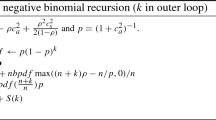Abstract
In this paper we are interested in the effect that dependencies in the arrival process to a queue have on queueing properties such as mean queue length and mean waiting time. We start with a review of the well known relations used to compare random variables and random vectors, e.g., stochastic orderings, stochastic increasing convexity, and strong stochastic increasing concavity. These relations and others are used to compare interarrival times in Markov renewal processes first in the case where the interarrival time distributions depend only on the current state in the underlying Markov chain and then in the general case where these interarrivai times depend on both the current state and the next state in that chain. These results are used to study a problem previously considered by Patuwo et al. [14].
Then, in order to keep the marginal distributions of the interarrivai times constant, we build a particular transition matrix for the underlying Markov chain depending on a single parameter,p. This Markov renewal process is used in the Patuwo et al. [14] problem so as to investigate the behavior of the mean queue length and mean waiting time on a correlation measure depending only onp. As constructed, the interarrival time distributions do not depend onp so that the effects we find depend only on correlation in the arrival process.
As a result of this latter construction, we find that the mean queue length is always larger in the case where correlations are non-zero than they are in the more usual case of renewal arrivals (i.e., where the correlations are zero). The implications of our results are clear.
Similar content being viewed by others
References
E. Çinlar, Analysis of systems of queues in parallel, PhD Dissertation, University of Michigan, Ann Arbor, MI (1965).
E. Çinlar, Queues with semi-Markovian arrivals, J. Appl. Prob. 4 (1967) 365–379.
R. Disney and P.C. Kiessler,Traffic Processes in Queueing Networks, A Markov Renewal Approach (The Johns Hopkins University Press, London, 1987).
C.S. Chang, X.L. Chao and M. Pinedo, Monotonicity results for queues with doubly stochastic Poisson arrivals: Ross's conjecture, Adv. Appl. Prob. 23 (1991) 210–228.
C.S. Chang, X.L. Chao, M. Pinedo and J.G. Shanthikumar, Stochastic convexity for multidimensional processes and its applications, IEEE Trans. Auto. Contr. AC-36 (1991) 1347–1355.
J.D. Esary, F. Proschan and D. Walkup, Association of random variables with applications, Ann. Math. Stat. 38 (1967) 1466–1474.
S. Karlin and Y. Rinott, Classes of orderings of measures and related correlation inequalities. I, Multivariate totally positive distributions, J. Multiv. Anal. 10 (1980) 467–498.
T.M. Liggett,Interacting Particle Systems (Springer, New York, 1985).
R.M. Loynes, The stability of a queue with non-independent interarrival and service times, Proc. Camb. Phil. Soc. 10 (1962) 561–581.
L. Meester and J.G. Shanthikumar, Regularity of stochastic processes: A theory based on directional convexity, Prob. Eng. Inf. Sci. 7 (1993) 343–360.
M.F. Neuts, Markov chains with applications in queueing theory, which have a matrix-geometric invariant probability vector, Adv. Appl. Prob. 10 (1978) 185–212.
M.F. Neuts,Matrix Geometric Solutions in Stochastic Models (The Johns Hopkins Univ. Press, Baltimore, 1981).
B.E. Patuwo, The effects of the dependency in the Markov renewal arrival process on the various performance measures of exponential server queues, PhD Dissertation, Virginia Polytechnic Institute and State University, Blacksburg, VA (1989).
B.E. Patuwo, R.L. Disney and D.C. McNickle, The effect of correlated arrivals on queues, IIE Trans. 25 (1993) 105–110.
T. Rolski, Comparison theorems for queues with dependent interarrival times:Modelling and Performance Evaluation, Proc. Int. Seminar, Paris (1983) pp. 42–67.
S.M. Ross, J.G. Shanthikumar and X. Zhang, Some pitfalls of black box queue inference: The case of state dependent server queues, Prob. Eng. Inf. Sci. 7 (1993) 149–157.
J.G. Shanthikumar and D. Yao, Strong stochastic convexity: closure properties and applications, J. Appl. Prob. 28 (1991) 131–145.
D. Stoyan,Comparison Methods for Queues and Other Stochastic Models (John Wiley, Berlin, 1983).
Author information
Authors and Affiliations
Rights and permissions
About this article
Cite this article
Szekli, R., Disney, R.L. & Hur, S. On performance comparison of MR/GI/1 queues. Queueing Syst 17, 451–470 (1994). https://doi.org/10.1007/BF01158704
Received:
Revised:
Issue Date:
DOI: https://doi.org/10.1007/BF01158704




